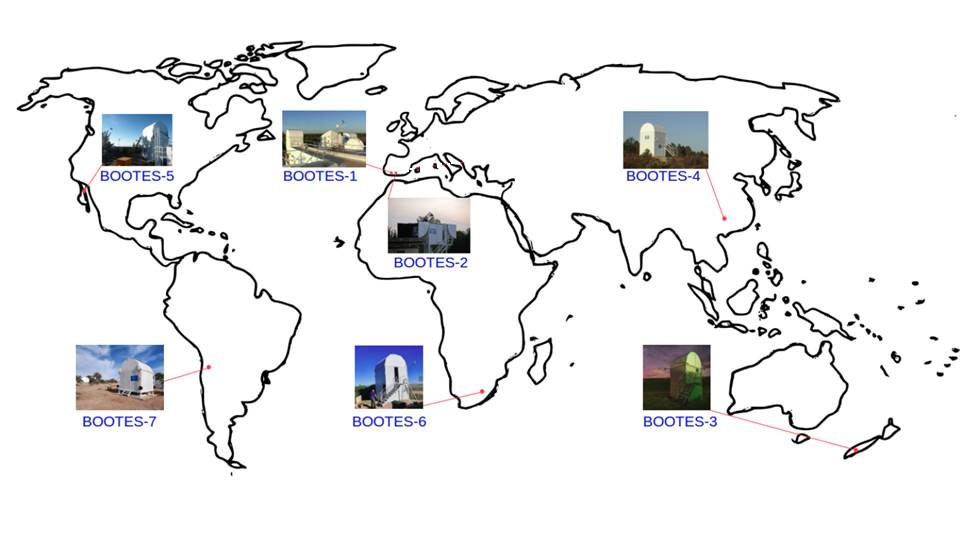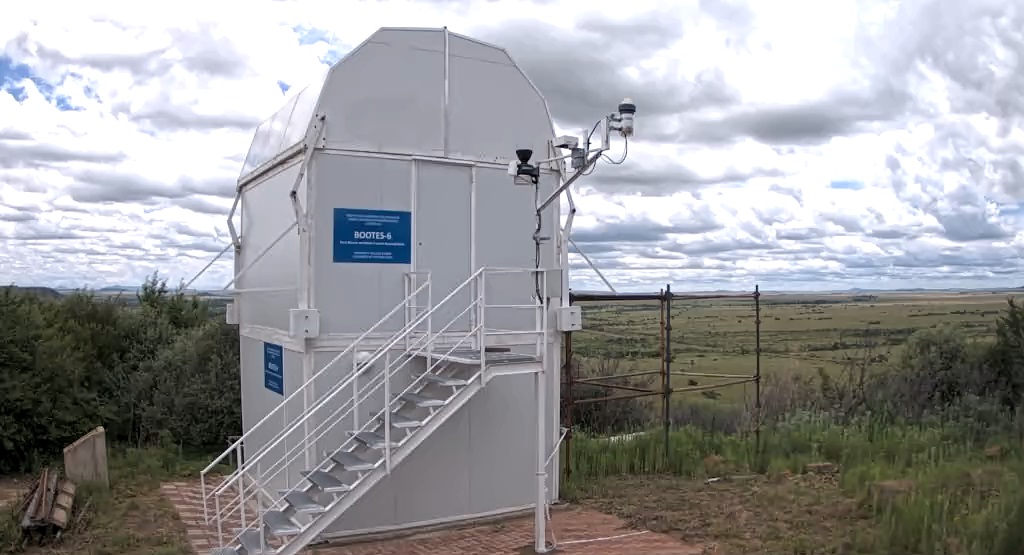The BOOTES network of telescopes dedicated to the search for transient events in the sky has just been completed with the construction of the last observatory!
This milestone means that we now have global coverage and can observe the night-sky constantly and completely, with observatories in both hemispheres and longitude distances between them that allow us to have one or two observatories in the night sky at any time.

The last two observatories located in South Africa and South America were installed in 2022. The first one, BOOTES-6, was installed in July and the second one, BOOTES-7, at the end of the year.
 BOOTES 6 Observatory
BOOTES 6 Observatory
 BOOTES 7 Observatory
BOOTES 7 Observatory
The main goal of this network is to detect and follow gamma ray bursts (GRBs), gamma ray explosions that are some of the most energetic known in the universe. The duration of these events is just a few seconds, so it is crucial to have a quick response in order to observe them and obtain valuable data. The network of robotic telescopes will allow us to have a constant and complete coverage of the night sky, which means that we will be able to observer any interesting transient event and will be prepared to obtain valuable data as soon as they occur.
“Twenty-four years after installing the first station of the Global BOOTES Network at the INTA-CEDEA Atmospheric Sounding Station in 1998, I have achieved my dream by being able to install the last astronomical station (BOOTES-7) in Atacama, Chile” says the team’s PI, Dr. A. J. Castro-Tirado. “A milestone for Spain, Andalusia, CSIC, the University of Malaga and all the institutions that have collaborated and continue to collaborate with us.“
This project has been a great collaborative effort and has involved scientists and technicians from all over the world. We have worked together for 24 years to get here and are very grateful for the support and work of all of them. We acknowledge the following institutions for having contributed to the milestone achieved with the completion of the global bootes network:
01 Instituto de Astrofísica de Andalucía (IAA-CSIC), P.O. Box 03004, E-18080 Granada, Spain
02 Departamento de Ingeniería de Sistemas y Automática, Escuela de Ingenierías, Universidad de Málaga, Dr. Pedro Ortiz Ramos, 29071 Málaga, Spain
03 Astronomical Institute, Academy of Sciences of the Czech Republic 251 65 Ondrejov, Czech Rep.
04 Faculty of Physics, Charles University, Ke Karlovu 3, 121 16 Praha 8, Czech Republic
05 Nikolaev National University, Nikolska str. 24, 54030 Nikolaev, Ukraine
06 Facultad de Ciencias, Universidad de Málaga, Bulevard Louis Pasteur, 29010 Málaga, Spain
07 Ense˜nanza Virtual y Laboratorios Tecnológicos, Universidad de Málaga, Jiménez Fraud 10, 29071 Málaga, Spain
08 ISDEFE for the SMOS FOS (ESA-ESAC), 28692 Villanueva de la Cañada (Madrid), Spain
09 Czech Technical University, Faculty of Electrical Engineering, Dep. of Radioelectronics, Technická 2 166 27 Prague, Czech Republic
10 Astronomical Institute of the Academy of Sciences, Bocní II 1401, CZ-14100 Praha 4, Czech Republic
11 Estación de Sondeos Atmosféricos (ESAt) de El Arenosillo (CEDEA-INTA), 21130 Mazagón, Huelva, Spain
12 Departamento de Ingeniería Electrónica, Sistemas Informáticos y Automática, Universidad de Huelva, E.T.S.I. de La Rábida, 21819 Palos de la Frontera (Huelva), Spain
13 Instituto de Hortofruticultura Subtropical y Mediterránea La Mayora (IHSM/UMA-CSIC), 29750 Algarrobo Costa (Málaga), Spain
14 Department of Physics, University of Auckland, Private Bag 92019, New Zealand
15 Vintage Lane Observatory, RD3, 7273 Blenheim, New Zealand
16 National Institute of Water and Atmospheric Research (NIWA), Lauder, New Zealand
17 Department of Physics, Sungkyunkwan University (SKKU), Suwon, Korea
18 Yunnan Astronomical Observatory, CAS, Kunming 650011, Yunnan, China
19 National Astronomical Observatory, Chinese Academy of Sciences, Beijing 100012, China
20 Instituto de Astronomía, Universidad Nacional Autónoma de México, 22800 Ensenada, Baja California, México
21 Instituto de Astronomía, Universidad Nacional Autónoma de México, Apdo Postal 70-264, Cd. Universitaria, 04510 México DF, México
22 Aryabhatta Research Institute of Observational Sciences, Manora Peak, Nainital – 263 002, India
23 Escuela Politécnica Superior, Universidad de Cádiz, Avda. Ramón Puyol, 11202 Algeciras (Cádiz), Spain
24 División de Ciencias del Espacio, Instituto Nacional de Técnica Aerospacial (INTA), 28850 Torrejón de Ardoz (Madrid), Spain